Abstract
Senescent human erythrocytes (RBC) are able to adhere to and be phagocytized by autologous monocytes in vitro to a greater extent than are young RBC. This adhesion and erythrophagocytosis of senescent RBC is inhibited by D-galactose, N-acetyl-D-galactosamine, their corresponding derivatives of bovine serum albumin, and lactose. On the other hand, D-glucose, D-mannose, L-fucose, N-acetyl-D-glucosamine, and their corresponding derivatives of bovine serum albumin are noninhibiting. The glycopeptides released by tryptic digestion of senescent RBC and purified on immobilized peanut agglutinin are the most effective inhibitors of both RBC adhesion and phagocytosis by autologous monocytes obtained from peripheral blood.
Full text
PDF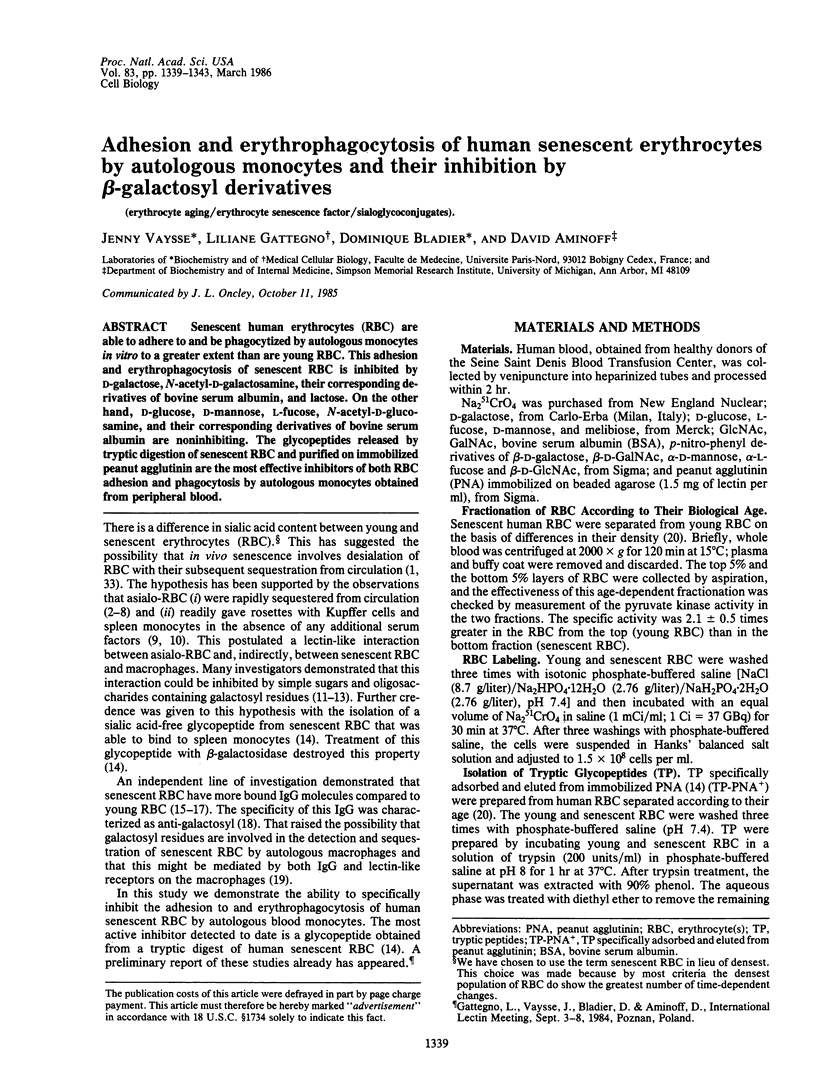
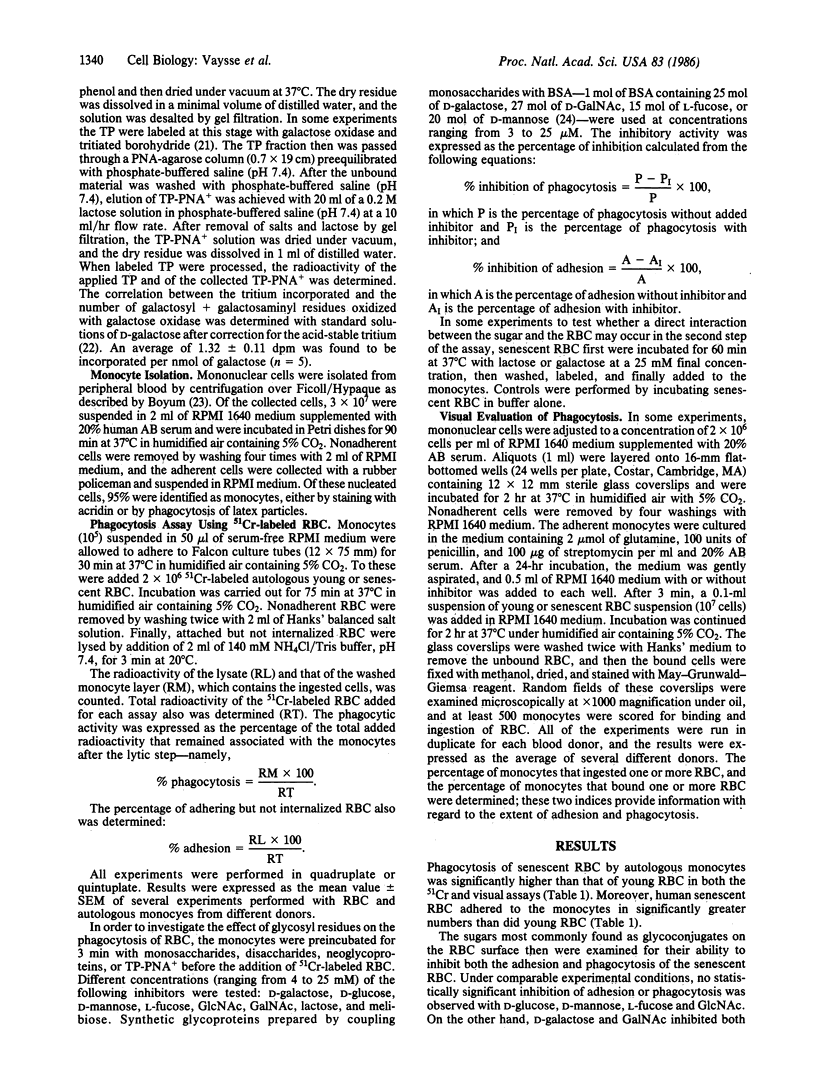
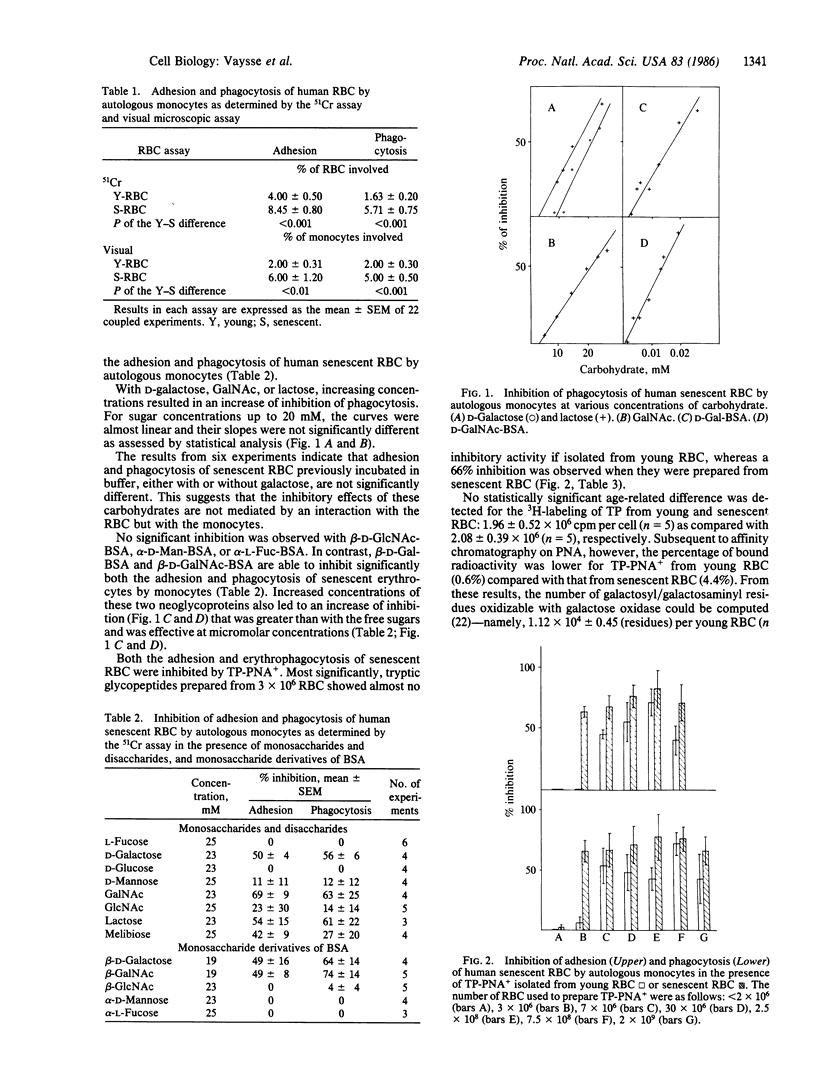
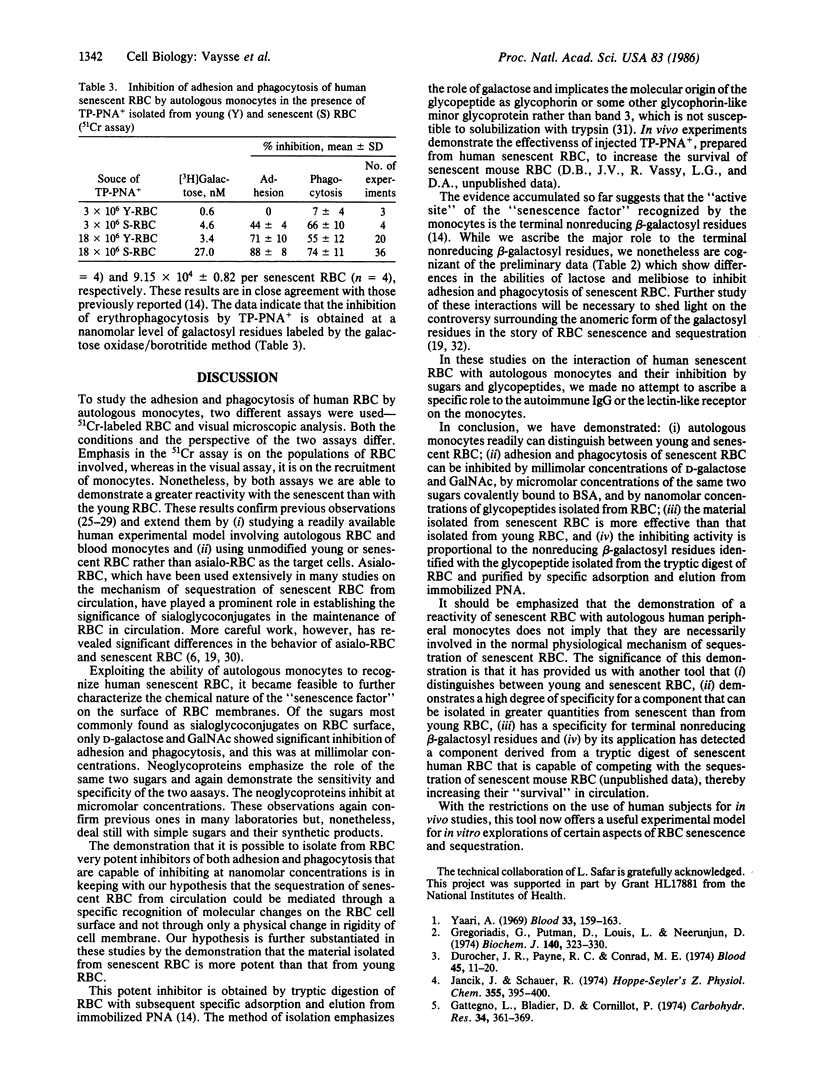
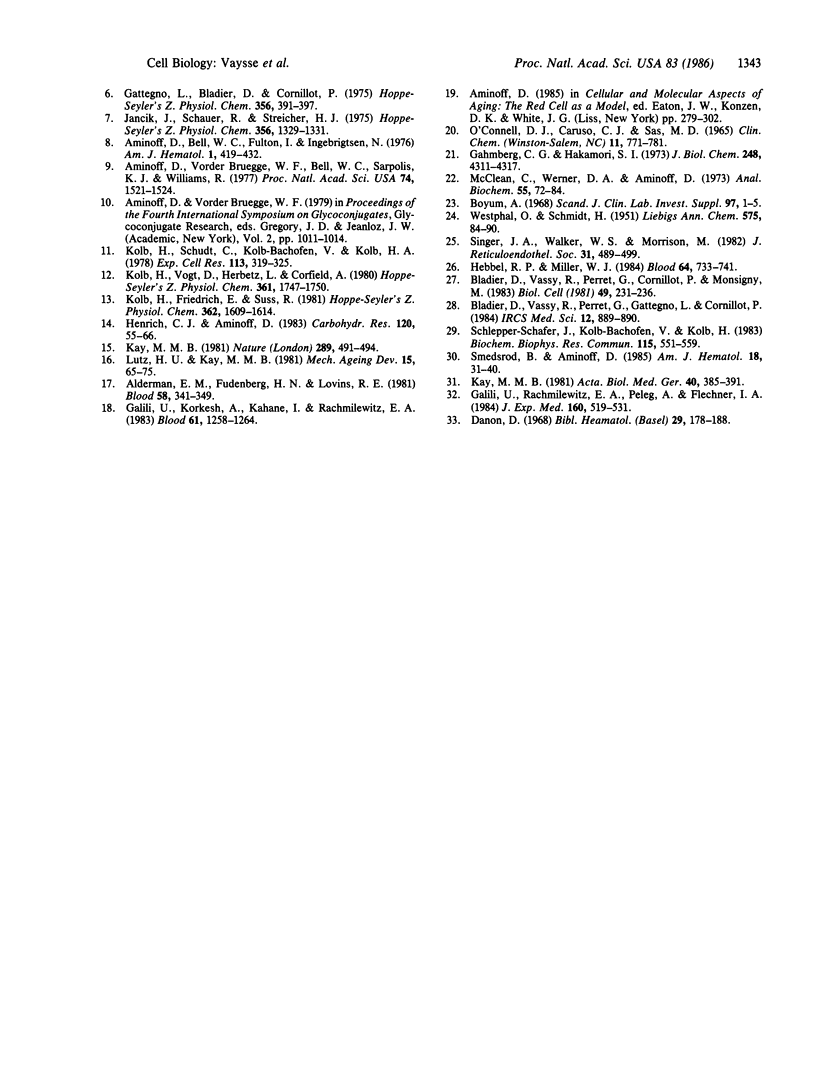
Selected References
These references are in PubMed. This may not be the complete list of references from this article.
- Alderman E. M., Fudenberg H. H., Lovins R. E. Isolation and characterization of an age-related antigen present on senescent human red blood cells. Blood. 1981 Aug;58(2):341–349. [PubMed] [Google Scholar]
- Aminoff D., Bell W. C., Fulton I., Ibgebrigtsen N. Effect of sialidase on the viability of erythrocytes in circulation. Am J Hematol. 1976;1(4):419–432. doi: 10.1002/ajh.2830010407. [DOI] [PubMed] [Google Scholar]
- Aminoff D., Bruegge W. F., Bell W. C., Sarpolis K., Williams R. Role of sialic acid in survival of erythrocytes in the circulation: interaction of neuraminidase-treated and untreated erythrocytes with spleen and liver at the cellular level. Proc Natl Acad Sci U S A. 1977 Apr;74(4):1521–1524. doi: 10.1073/pnas.74.4.1521. [DOI] [PMC free article] [PubMed] [Google Scholar]
- Bladier D., Vassy R., Perret G., Cornillot P., Monsigny M. Red cell ageing: phagocytosis and life-span of young and old erythrocytes fractionated by centrifugation. Biol Cell. 1983;49(3):231–236. doi: 10.1111/j.1768-322x.1984.tb00242.x. [DOI] [PubMed] [Google Scholar]
- Danon D. Biophysical aspects of red cell ageing. Bibl Haematol. 1968;29:178–188. doi: 10.1159/000384604. [DOI] [PubMed] [Google Scholar]
- Durocher J. R., Payne R. C., Conrad M. E. Role of sialic acid in erythrocyte survival. Blood. 1975 Jan;45(1):11–20. [PubMed] [Google Scholar]
- Gahmberg C. G., Hakomori S. I. External labeling of cell surface galactose and galactosamine in glycolipid and glycoprotein of human erythrocytes. J Biol Chem. 1973 Jun 25;248(12):4311–4317. [PubMed] [Google Scholar]
- Galili U., Korkesh A., Kahane I., Rachmilewitz E. A. Demonstration of a natural antigalactosyl IgG antibody on thalassemic red blood cells. Blood. 1983 Jun;61(6):1258–1264. [PubMed] [Google Scholar]
- Gattegno L., Bladier D., Cornillot P. Ageing in vivo and neuraminidase treatment of rabbit erythrocytes: influence on half-life as assessed by 51Cr labelling. Hoppe Seylers Z Physiol Chem. 1975 Apr;356(4):391–397. doi: 10.1515/bchm2.1975.356.1.391. [DOI] [PubMed] [Google Scholar]
- Gattegno L., Bladier D., Cornillot P. The role of sialic acid in the determination of survival of rabbit erythrocytes in the circulation. Carbohydr Res. 1974 Jun;34(2):361–369. doi: 10.1016/s0008-6215(00)82911-0. [DOI] [PubMed] [Google Scholar]
- Gregoriadis G., Putman D., Louis L., Neerunjun D. Comparative effect and fate of non-entrapped and liposome-entrapped neuraminidase injected into rats. Biochem J. 1974 May;140(2):323–330. doi: 10.1042/bj1400323. [DOI] [PMC free article] [PubMed] [Google Scholar]
- Hebbel R. P., Miller W. J. Phagocytosis of sickle erythrocytes: immunologic and oxidative determinants of hemolytic anemia. Blood. 1984 Sep;64(3):733–741. [PubMed] [Google Scholar]
- Henrich C. J., Aminoff D. Isolation and characterization of a glycopeptide from human senescent erythrocytes. Carbohydr Res. 1983 Aug 16;120:55–66. doi: 10.1016/0008-6215(83)88006-9. [DOI] [PubMed] [Google Scholar]
- Jancik J., Schauer R. Sialic acid--a determinant of the life-time of rabbit erythrocytes. Hoppe Seylers Z Physiol Chem. 1974 Apr;355(4):395–400. doi: 10.1515/bchm2.1974.355.1.395. [DOI] [PubMed] [Google Scholar]
- Jancik J., Schauer R., Streicher H. J. Influence of membrane-bound N-acetylneuraminic acid on the survival of erythrocytes in man. Hoppe Seylers Z Physiol Chem. 1975 Aug;356(8):1329–1331. [PubMed] [Google Scholar]
- Kay M. M. Isolation of the phagocytosis-inducing IgG-binding antigen on senescent somatic cells. Nature. 1981 Feb 5;289(5797):491–494. doi: 10.1038/289491a0. [DOI] [PubMed] [Google Scholar]
- Kay M. M. The IgG autoantibody binding determinant appearing on senescent membranes residues on a 62000 MW peptide. Acta Biol Med Ger. 1981;40(4-5):385–391. [PubMed] [Google Scholar]
- Kolb H., Friedrich E., Süss R. Lectin mediates homing of sialidase-treated erythrocytes of the liver as revealed by scintigraphy. Hoppe Seylers Z Physiol Chem. 1981 Dec;362(12):1609–1614. doi: 10.1515/bchm2.1981.362.2.1609. [DOI] [PubMed] [Google Scholar]
- Kolb H., Schudt C., Kolb-Bachofen V., Kolb H. A. Cellular recognition by rat liver cells of neuraminidase-treated erythrocytes. Demonstration and analysis of cell contacts. Exp Cell Res. 1978 May;113(2):319–325. doi: 10.1016/0014-4827(78)90372-5. [DOI] [PubMed] [Google Scholar]
- Kolb H., Vogt D., Herbertz L., Corfield A., Schauer R., Schlepper-Schäfer J. The galactose-specific lectins on rat hepatocytes and Kupffer cells have identical binding characteristics. Hoppe Seylers Z Physiol Chem. 1980 Nov;361(11):1747–1750. [PubMed] [Google Scholar]
- Lutz H. U., Kay M. M. An age-specific cell antigen is present on senescent human red blood cell membranes. A brief note. Mech Ageing Dev. 1981 Jan;15(1):65–75. doi: 10.1016/0047-6374(81)90008-7. [DOI] [PubMed] [Google Scholar]
- McLean C., Werner D. A., Aminoff D. Quantitative determination of reducing sugars, oligosaccharides, and glycoproteins with (3H)borohydride. Anal Biochem. 1973 Sep;55(1):72–84. doi: 10.1016/0003-2697(73)90291-1. [DOI] [PubMed] [Google Scholar]
- O'CONNELL D. J., CARUSO C. J., SASS M. D. SEPARATION OF ERYTHROCYTES OF DIFFERENT AGES. Clin Chem. 1965 Aug;11:771–781. [PubMed] [Google Scholar]
- Schlepper-Schäfer J., Kolb-Bachofen V., Kolb H. Identification of a receptor for senescent erythrocytes on liver macrophages. Biochem Biophys Res Commun. 1983 Sep 15;115(2):551–559. doi: 10.1016/s0006-291x(83)80180-6. [DOI] [PubMed] [Google Scholar]
- Singer J. A., Walker W. S., Morrison M. Interaction of a mouse macrophage cell line with homologous erythrocytes. J Reticuloendothel Soc. 1982 Jun;31(6):489–499. [PubMed] [Google Scholar]
- Smedsrød B., Aminoff D. Use of 75Se-labeled methionine to study the sequestration of senescent red blood cells. Am J Hematol. 1985 Jan;18(1):31–40. doi: 10.1002/ajh.2830180106. [DOI] [PubMed] [Google Scholar]
- Yaari A. Mobility of human red blood cells of different age groups in an electric field. Blood. 1969 Feb;33(2):159–163. [PubMed] [Google Scholar]


